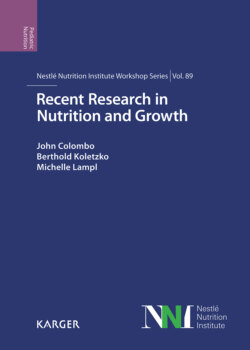Читать книгу Recent Research in Nutrition and Growth - Группа авторов - Страница 41
На сайте Литреса книга снята с продажи.
Effect of Developmental Age on the Capacity to Recuperate Muscle Mass
ОглавлениеWe have assessed the short- and long-term consequences of suboptimal nutrition on the processes that regulate skeletal muscle growth during the perinatal period in experimental models. To identify the specific importance of the timing of the nutritional insult on the recuperative capacity of muscles, we have used a mouse model in which offspring were undernourished either from birth to 11 days of age (early undernutrition, EUN) or from 11 to 22 days of age (late undernutrition, LUN) [15]. To achieve the restriction, dams were fed a restricted protein diet ad libitum throughout lactation which limits milk production with little effect on milk macronutrient composition. Thus, pups essentially experience a global nutrient deficit. Following the period of restriction, nutritional rehabilitation was instituted either by suckling pups on well-nourished dams (EUN) or by providing them a control diet (LUN). The EUN group, therefore, experienced a growth deficit in a highly anabolic period, but was recovered before their muscles attained maturity. The LUN group was undernourished for the same length of time but recovered at a more advanced stage of maturity when there is little myonuclear proliferation, and muscle hypertrophy is primarily due to protein accretion. We observed that EUN resulted in a greater deficit in muscle protein than LUN (Fig. 2a). With refeeding, the EUN pups mounted a robust anabolic response and muscle protein mass was recovered (Fig. 2a). However, although the LUN pups exhibited some initial catchup growth, this was not sustained, and a deficit in muscle protein mass persisted into old age [15]. To identify the mechanisms responsible for the disparate responses, we assessed the protein-synthetic response to refeeding. We observed that with refeeding EUN pups accelerated postprandial protein synthesis above control levels and sustained this enhanced response until muscle protein mass was restored to the level of well-nourished controls. The LUN offspring exhibited a blunted response that was insufficient to restore muscle mass. Evaluation of the regulatory processes revealed no differences in the efficiency of the signaling pathways that stimulate translation initiation. In contrast, the more immature muscle of EUN offspring increased ribosomal abundance upon refeeding, a response that did not occur in the older LUN group. Further evaluation established that the increased ribosomal abundance was associated with increased expression of the nucleolar transcription factor, UBF, in EUN but not LUN progeny. This factor plays a critical function in regulating rRNA transcription, the limiting factor for ribosomal production.
Like the response in protein accretion, accumulation of myonuclei is also sensitive to nutrient supply during the early life phase of muscle growth. Suboptimal nutrition invariably has been associated with a reduction in myonuclei [23], and reduced satellite cell numbers and proliferative activity have been observed in various animal models of intrauterine and neonatal nutrient restriction [24] and in muscles of undernourished children [25]. In newborn pigs, within less than 48 h of feeding a diet providing adequate energy but only 50% of protein requirements, satellite cell proliferation had decreased to approximately 60% of control levels [26]. However, it was uncertain whether satellite cell proliferation could recover to restore myonuclear numbers and support catchup growth when the nutritional insult extends into the postnatal period. Thus, we used the previously described nutritional paradigm and determined that in both EUN and LUN groups there was a similar deficit of approximately 20% in satellite cells (Fig. 2b) and myonuclei (Fig. 2c) at the end of the period of undernutrition. Following 3 weeks of refeeding, satellite cell and myonuclear abundance were restored in the EUN group, but there was no restoration of satellite cell numbers and only a modest improvement in myonuclei in the LUN group.
